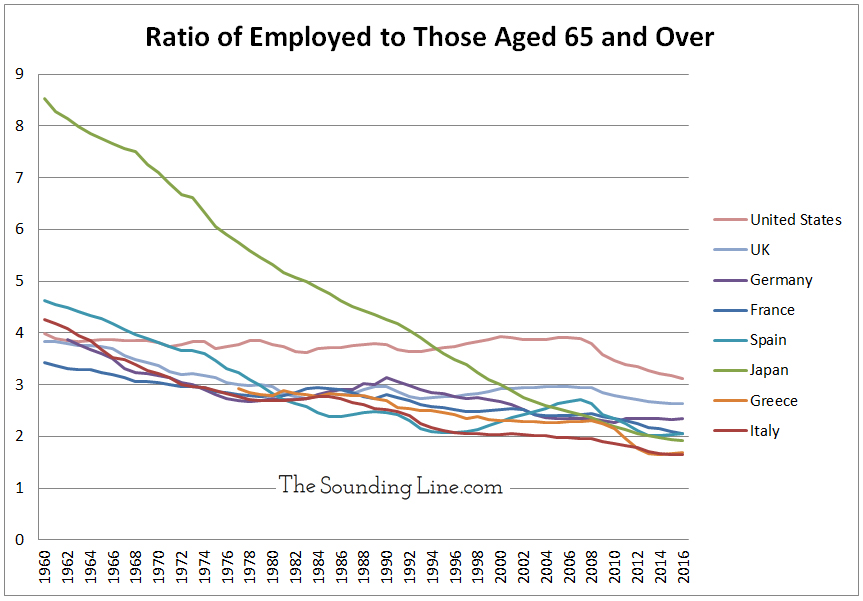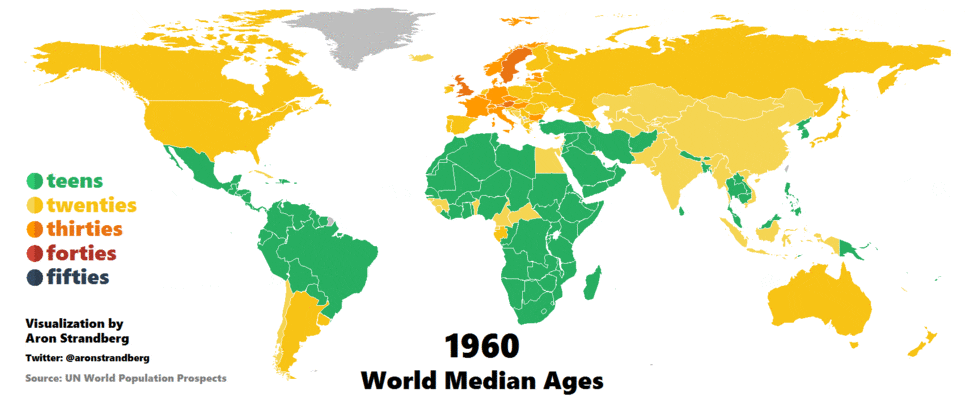Submitted by Taps Coogan on the 5th of September 2018 to The Sounding Line.
Enjoy The Sounding Line? Click here to subscribe for free.
Fertility rates are falling, fewer babies are being born, and average lifespans are increasing. The result is a stark and universal global aging, particularly pronounced among developed economies in Europe and the Americas. As the following maps from Aron Strandberg attests, the median age is getting older in every single county on Earth. The average age in the United States in 1960 was 29 years old. Today it is 38 years old and by 2060 it will be 42 years old. In Italy, the median in 1960 was 32, today it is 47, and by 2060 it will be 51. In Japan the median age was 25 in 1960, today it is 47, and by 2060 it will be 53.
Europe:
Animation: Median Age in Europe 1960 – 2060 (Projection) pic.twitter.com/UF6NV40Evw
— Aron Strandberg (@aronstrandberg) March 7, 2016
Africa:
Animation: Median Age in Africa 1960 – 2060 (Projection) pic.twitter.com/3vLUGulHSx
— Aron Strandberg (@aronstrandberg) March 7, 2016
Middle East:
Animation: Median Age in the Middle East 1960 – 2060 (Projection) pic.twitter.com/ny7DpCX6Bj
— Aron Strandberg (@aronstrandberg) March 7, 2016
Asia-Pacific:
Animation: Median Age in Asia-Pacific 1960 – 2060 (Projection) pic.twitter.com/Qe6cYEIEf9
— Aron Strandberg (@aronstrandberg) March 8, 2016
Americas:
Animation: Median Age in the Americas 1960 – 2060 (Projection) pic.twitter.com/W8ebewNiq0
— Aron Strandberg (@aronstrandberg) March 8, 2016
The good news is that life expectancy is trending higher in most countries around the world. That means healthier and longer lives for most people. The bad news is that aging populations mean an ever decreasing percentage of the global population is working age and an ever increasing percentage of people is retired. As we have discussed on numerous occasions here at The Sounding Line, declining ratios of workers to retirees and decades of expanding welfare and retirement benefits are putting pension systems and governments around the world under increasing strain.
The OECD reports that in Japan “the working age population is falling by about 1 percent per year, and the rate of shrinkage will eventually approach 1.7 percent per year, so that even productivity growth of 2% or more will deliver very low aggregate or per capita growth…There will simply be no way to sustain high living standards and quality public standards in a ‘super-aging’ Japan unless the country is able to achieve much higher rates of productivity growth.” In the US, entitlement programs have grown from less than 2% of GDP in the 1950s to nearly 14% today, a percentage which is expected to continue to grow more rapidly in coming years. Today there are fewer than three workers per retirement age citizen in nearly every developed economy. In Japan there are slightly less than two. In Italy and Greece there are barely more than 1.5 workers per senior, less than half the ratio in the 1960s.

Aside from an increase in birth rates, the only solution to the economic problems posed by an aging global populations is increased economic productivity. Unfortunately, productivity has remained stubbornly flat among developed economies, particularly in the European Union, where increasing tax and regulatory burdens have dis-incentivized capital investment and smothered new business and innovation.
If you would like to be updated via email when we post a new article, please click here. It’s free and we won’t send any spam.
Would you like to be notified when we publish a new article on The Sounding Line? Click here to subscribe for free.


